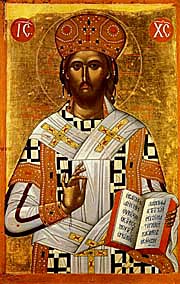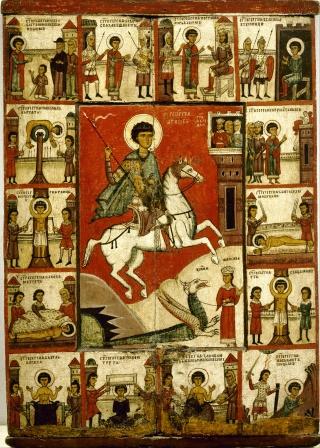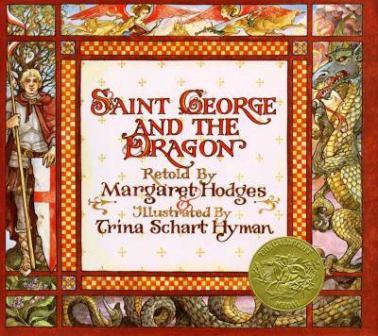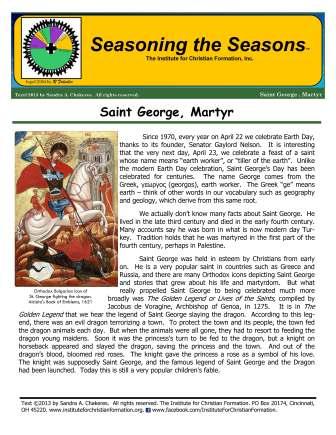The Institute for Christian Formation

Saint George, Martyr
Feast Day (optional memorial): April 23
Follow us on Facebook to keep up to date with our news and newest resources!
Since 1970, every year on April 22 we celebrate Earth Day, thanks to its founder, Senator Gaylord Nelson. It is interesting that the very next day, April 23, we celebrate a feast of a saint whose name means “earth worker”, or “tiller of the earth”. Unlike the modern Earth Day celebration, Saint George’s Day has been celebrated for centuries. The name George comes from the Greek, γεωργος (georgos), earth worker. The Greek “ge” means earth – think of other words in our vocabulary such as geography and geology, which derive from this same root.
We actually don’t know many facts about Saint George. He lived in the late third century and died in the early fourth century. Many accounts say he was born in what is now modern day Turkey. Tradition holds that he was martyred in the first part of the fourth century, perhaps in Palestine.
There is a series of six stained glass windows, designed by Dante Gabriel Rossetti, which shows the legend of St George. You can view these and find out more information from the Victoria and Albert Museum here.
How will you celebrate Saint George’s Day? Grace your table with a fresh red rose. Read a book, perhaps gathering children around to read the story of Saint George and the Dragon. Prepare pa de Sant Jordi, a traditional bread sold in bakeries throughout Barcelona on Saint George’s feast day. Here is background information on this bread, as well as the one sample of a recipe. And since Saint George is the patron saint of England, you could have a traditional English dinner. Some traditional English recipes can be found here. Just think…when your children ask what’s for dinner you can reply, “Mustard toad in the hole”! And if you happen to be a scout troop leader, don’t forget that Saint George
Both William Shakespeare and Miguel de Cervantes died on April 23, 1616. Booksellers are not to be outdone on Saint George’s Day in Barcelona, where females purchase a book to give their significant male in exchange for the rose.
Miracle of St George and the Dragon,
with Scenes from his Life.
Novgorod, First half of 14th century
State Russian Museum, St Petersburg

Saint George was held in esteem by Christians from early on. He is a very popular saint in countries such as Greece and Russia, and there are many Orthodox icons depicting Saint George and stories that grew about his life and martyrdom. But what really propelled Saint George to being celebrated much more broadly was The Golden Legend or Lives of the Saints, compiled by Jacobus de Voragine, Archbishop of Genoa, in 1275. It is inThe Golden Legend that we hear the legend of Saint George slaying the dragon. According to this legend, there was an evil dragon terrorizing a town. To protect the town and its people, the town fed the dragon animals each day. But when the animals were all gone, they had to resort to feeding the dragon young maidens. Soon it was the princess’s turn to be fed to the dragon, but a

knight on horseback appeared and slayed the dragon, saving the princess and the town. And out of the dragon’s blood, bloomed red roses. The knight gave the princess a rose as a symbol of his love. The knight was supposedly Saint George, and the famous legend of Saint George and the Dragon had been launched. Today this is still a very popular children’s fable, with one of the classic books being “Saint George and the Dragon” as retold by Margaret Hodges and illustrated by Trina Schart Hyman. Most public libraries have this book on their shelves.
Saint George’s Day – April 23rd – is an even bigger celebration in Catalonia, where it is celebrated in Barcelona almost as we celebrate Valentine’s Day in the USA. Roses, especially red roses, are a big seller on this day, when every male gives his female love a rose. To be female without receiving a rose on this day in Barcelona is a sad fate, indeed. But not to worry – bosses give roses to their female employees, shop owners give roses to their customers, and roses are even distributed on the streets to females unknown by the giver! But the males are not forgotten, either. April 23 also is the date when two literary giants died.

You just know when you have a legend of a brave knight on horseback slaying an evil dragon and saving a princess, this legend is going to have a profound impact on a country such as England. Even though Saint George was not really a knight, did not actually slay a dragon, and never set foot in England, he is still the patron saint of that country and April 23rd – Saint George’s Day – is even the national holiday. A tradition says you should wear a red rose in your lapel on Saint George’s Day. Recall the legend of red roses blooming from the slain dragon’s blood and the dragon-slaying knight giving a red rose to the princess whose life he saved.

Click on the image above to download our ICF bulletin on Saint George.
is the Patron Saint of Boy Scouts, so perhaps some dragon shaped cookies might be the treat for the troop on this feast!
However you choose to celebrate Saint George’s Day on April 23, don’t forget the true meaning of the day. Saint George loved Christ so much he was willing to give his life as a martyr for his faith. And if a dragon is a symbol of evil, how do we slay the dragons (hatred, evil, etc.) that we witness in our lives? We do so by the light of Christ, which we received at baptism. During this Easter Season, our prominently placed Paschal Candle reminds us that Christ is the light that dispels all darkness. And to that we say, “Amen. Alleluia!”
